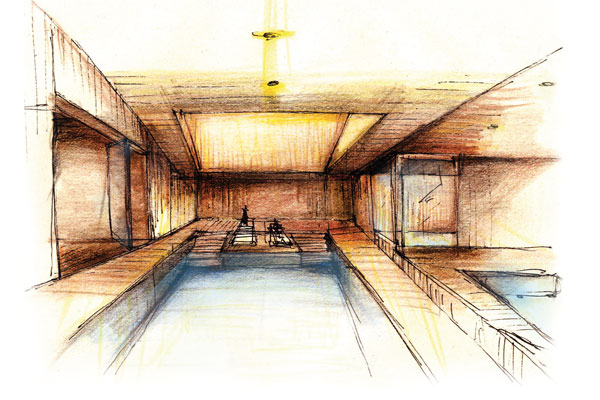In Cubes Indesign C68’s Coda ‘In the Drawer’ series where we highlight unrealised projects, we’ve featured a graduating project from Singapore Polytechnic’s Diploma in Interior Design course. Here Luo Jingmei finds out more about the other studio projects that tackle living, working and playing underground.

July 7th, 2014
In academia, recognising and dealing with real issues is just as important as dreaming up incredible ideas. For one third-year studio (or atelier) from Singapore Polytechnic Design School’s Diploma in Interior Design Course, the issue at hand was Singapore’s land scarcity, which prompted the idea of designing facilities underground.

Subterranean Retreat by Lim Joo Yee
“The project’s brief was developed on the trail of a series of articles regarding ownership of subterranean land and people’s impressions of subterranean living/working following the Minister for National Development Khaw Boon Wan announcing in September 2013 that URA (Urban Redevelopment Authority) will be launching a subterranean master plan,” says course master Christopher Goh. “As part of our Futures Atelier, we crafted the brief for subterranean spaces on the premise of sculpting an interior space. Students were briefed on designing the spatial experience of a subterranean project, taking into account factors such as the requirement for sunlight and natural ventilation within all spaces.”
Before embarking on the project, titled “Terra Incognita”, the atelier conducted a random public survey of more than 530 people on their views of subterranean living, and found out more about URA’s vision for the subterranean master plan. Furthermore, the school also had a collaborative workshop with the National Institute of Design, India, where Professor Praveen Nahar ran an insightful workshop with the students in developing materials and ideas for subterranean spaces.
Fort Canning Hill was chosen as the locale of experimentation and the students came up with a diversity of schemes. Campgrounds and nature-inspired retreats were a natural response to the nature of the park grounds, one example of which was Lim Joo Yee’s ‘Subterranean Retreat’ featured in Coda in Cubes Indesign. Another was Lee Si Hui’s ‘Urban Retreat’, a series of villas where one could find respite from the cacophony of urban life.
“My project looked into enhancing the retreat in the park… it was designed to interact with the naturally occurring daylight within the villa, with sky funnels conceptualised to block out the cityscape yet allow an interplay of daylight as it scalpels through the canopy into the villas. Natural water features were also created simply through rain flowing over the terraced villas stacked against the hill, paying tribute to the natural terrain,” she says. In addition, an exceptionally high ceiling of 10 metres was considered to minimise the possible claustrophobia of being underground, and plants were incorporated at the foot of the sky funnels within each villa with the intention of bringing “a part of Fort Canning Park into the villas.”

Kelly Chan’s proposal, at the existing Registry of Marriages
Meanwhile, more unique propositions saw students like Kelly Chan enhancing the ritualistic experience at the existing Registry of Marriages (ROM) at the Park, and Omar Shiddiq Bin Masodi and Soh Siew Kim’s public-focussed schemes (‘Art House’ and ‘The Oratorium’ respectively) inspired by the beloved, defunct National Theatre that used to be located at the Park.

Art House by Omar Shiddiq Bin Masodi
To note, the community aspect in Soh’s project takes on interesting forms, melding idealism and innovation. Aside from conventional performance and workshop spaces, sprawled across the site is a series of ‘speaking pods’ where members of the public can “air their opinions openly and anonymously without the fear of being judged.” The vocal outlets of the pods are located a distance away from the speaker stands to facilitate this.
For sure, going underground is not a new topic in the realm of architecture discourse. But with Singapore’s growing population and simultaneously increasing lack of land space, it’s a relevant issue to start addressing. These student propositions, while not all implementable, provide some food for thought and actually makes descending underground not such a bad idea.
Singapore Polytechnic
sp.edu.sg
INDESIGN is on instagram
Follow @indesignlive
A searchable and comprehensive guide for specifying leading products and their suppliers
Keep up to date with the latest and greatest from our industry BFF's!

Merging two hotel identities in one landmark development, Hotel Indigo and Holiday Inn Little Collins capture the spirit of Melbourne through Buchan’s narrative-driven design – elevated by GROHE’s signature craftsmanship.

For a closer look behind the creative process, watch this video interview with Sebastian Nash, where he explores the making of King Living’s textile range – from fibre choices to design intent.

In an industry where design intent is often diluted by value management and procurement pressures, Klaro Industrial Design positions manufacturing as a creative ally – allowing commercial interior designers to deliver unique pieces aligned to the project’s original vision.

At the Munarra Centre for Regional Excellence on Yorta Yorta Country in Victoria, ARM Architecture and Milliken use PrintWorks™ technology to translate First Nations narratives into a layered, community-led floorscape.
The internet never sleeps! Here's the stuff you might have missed

A collaboration between Hassell, Weston Williamson + Partners (WW+P Architects) and Rogers Stirk Harbour + Partners (RSHP) sees the opening of five new underground stations.

Milliken’s ‘Reconciliation Through Design’ initiative is amplifying the voices of Aboriginal and Torres Strait Islander artists, showcasing how cultural collaboration can reshape the design narrative in commercial interiors.